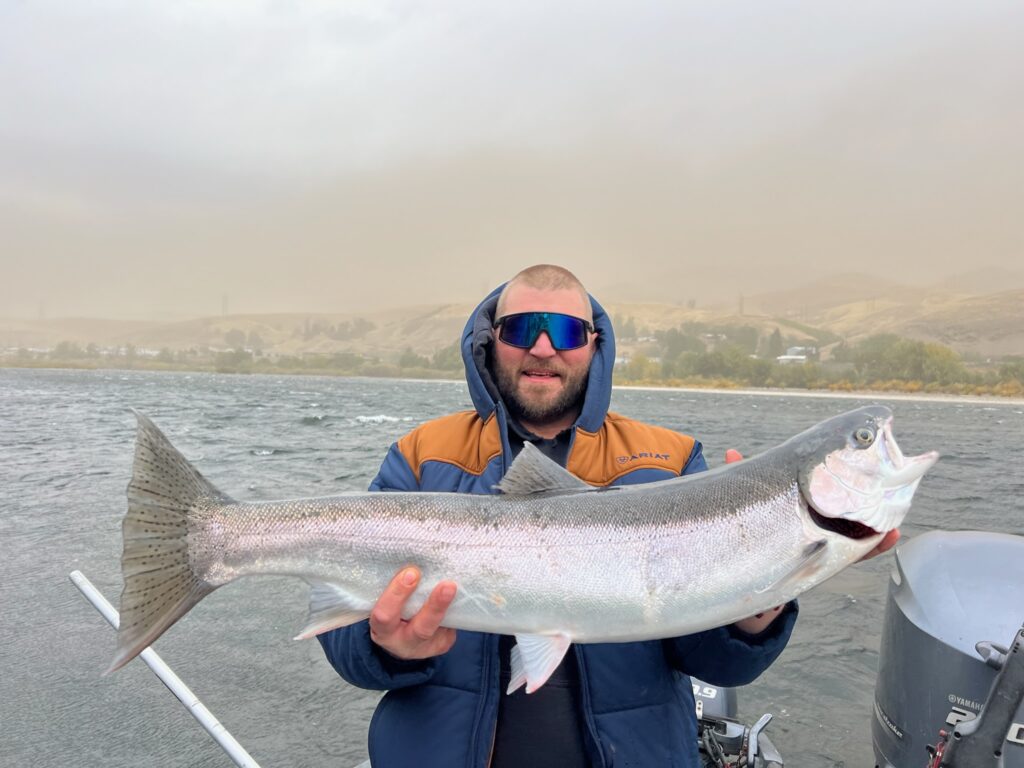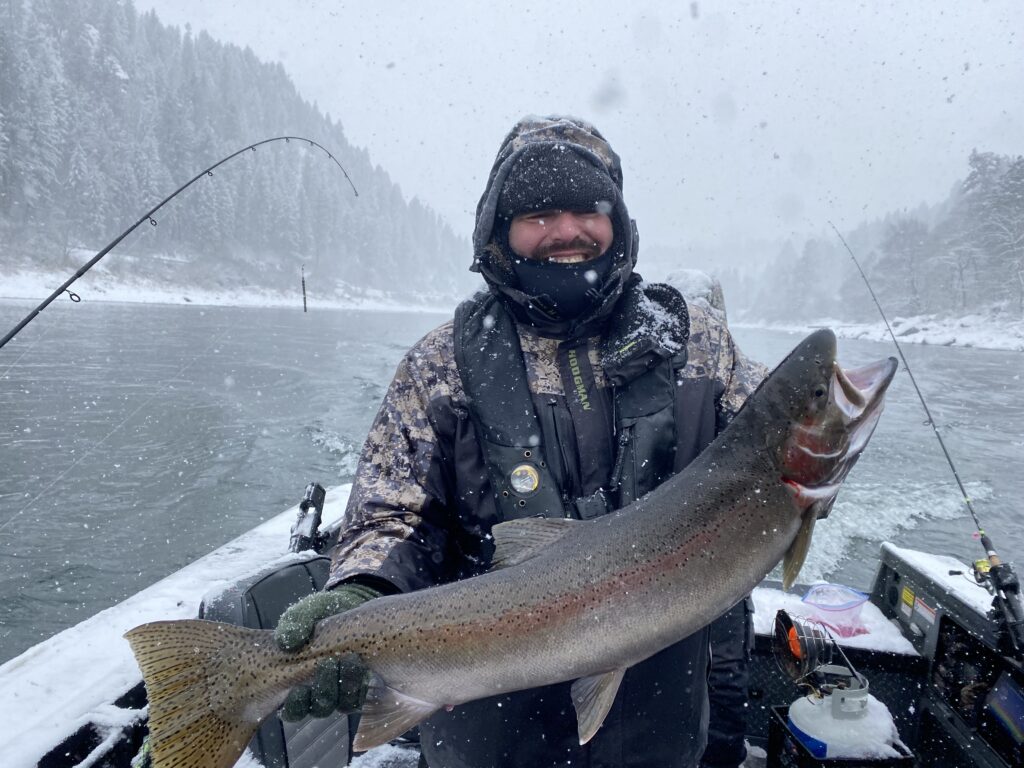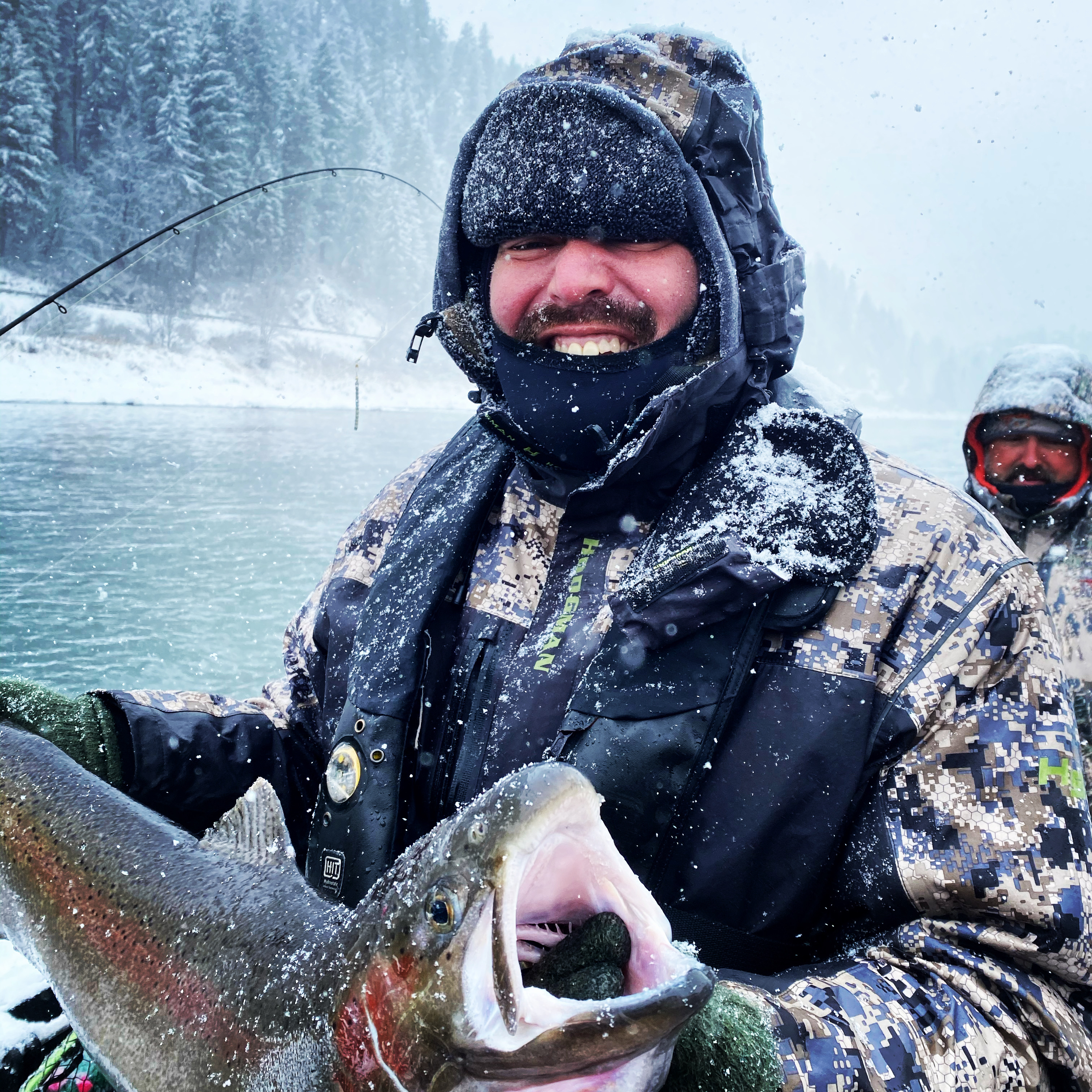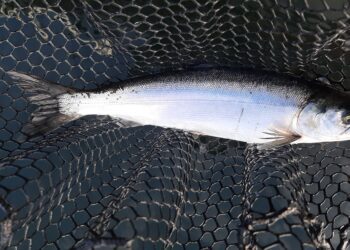Let’s start with a recap of Steelhead season 2024 early predictions called for a record run.
JULY & AUGUST
Most people were skeptical considering the last 15 years have been less than stellar. Snake River Steelhead enter the Columbia River in July and August and unlike Salmon, Steelhead migrate slower. They often stop in areas known as cold water refuges for many days, or sometimes weeks, on their way upriver to spawn.
The first thing we noticed was higher numbers of fish than we were accustomed to seeing over the last 15 years. The second thing we noticed was the fish were mostly bigger B-run steelhead. Steelhead are classified into two groups: A-run identified as a Steelhead under 30″, and B–over 30″.
A-run spend 1 year in the ocean, and B-run spend 2 or more. September 1st when the Steelhead Season opened on the Snake River, we had a good feel for the run. Fishery managers had pumped up the run and the numbers crossing each dam did not lie. It’s going to be a good year.

SEPTEMBER
September for my company, Reel Time Fishing, is primarily spent trolling 360 flasher setups or hovering eggs targeting King Salmon around the Confluence of the Snake and Clearwater rivers. This area has a temperature difference known as a thermal barrier. In this case, the Clearwater is close to 10 degrees colder than the Snake River. Salmon fishing was slow this September but the Steelhead fishing was much better. It was strange to tell the clients Salmon is slow, while Steelhead is hot.
We had a lot of success trolling bobbers and shrimp at an ultra-slow pace in the usual steelhead spots around the bridges and the neutral water flat on the north side of the confluence. We also caught a fair amount on our Salmon gear superbaits and spinners as the season progressed we started to move upriver to the free-flowing areas of the Clearwater trolling Maglips by Yakima Bait and Bradss Wiggler. These plugs tipped with a shrimp are a deadly combination.

NOVEMBER & DECEMBER
That brings us to the now. Currently, the Steelhead are through all river systems and anglers are enjoying both the increased numbers and size. In my 35 years of guiding experience, this is how the rest of the season should shape up: Steelhead are going to hang in the slower water around Lewiston, Clarkston, and Asotin to wait for a good shot of rain that signals the fish to move upriver.
This makes November and December amazing fishing in the slack water in the day and the night. Yes, I said night. Night fishing is allowed and it can be very productive pulling lighted lures like the old Brads Wigglers, Vortex and the new Night Strike day time. I would concentrate on Bobber and Shrimp around the bridges and in the neutral water in the confluence on the north side or trolling 360 flashers and a very small spinner such as the 3.0 colorado blade in shades gold, chartreuse, and green.
Many steelhead can be caught upriver as well. The Clearwater is an amazing bank fishery that targets deeper slower runs with bobber and shrimp. If you prefer fishing upriver from a boat my suggestion is Heller Bar or the entire Clearwater from Lewiston to Orofino. Keep in mind these river systems are very dangerous, a person can get into trouble not knowing the water. I suggest hiring one of the many local guide services to show you the river.

JANUARY & FEBRUARY
After the first of the year, most of the Steelhead will begin to head to areas closer to their spawning grounds but keep in mind Steelhead migration is unique. Sometimes they actually move downriver for some time. For example, during January and February, you can still catch fish in the Lewiston-Clarkston area but there are definitely less fish hanging around in this area.
On the Clearwater, anglers will begin to pile into the Orofino area targeting the fish from Dworshak hatchery, the largest Steelhead hatchery in the world. Amazing bank fishing can be had on the North Fork of the Clearwater below Dworshak Dam.
Other hot spots include the Cottonwood Creek hatchery on the Grande Ronde, and Mouth of the Little Salmon on the Salmon River. These areas are all hotspots and because of this, they are high-traffic areas. If you would like to avoid the crowds, fish river sections up to 15 miles downriver of these hot spots and just cover some ground. The fish aren’t as concentrated, so it’ll likely be a situation where you find one here and there.
MARCH & APRIL
In March and April, all the fish will be piled up near hatcheries or spawning grounds. This is a hot time for Orofino, Clear Creek hatchery, and the south fork of the Clearwater. Little Salmon heats up in Riggins Idaho, the Cottonwood creek area on the Grande Ronde, and Hell’s Canyon dam will begin to produce.
LATE SEASON
Let’s talk techniques for these late-season fish. The #1 technique is drifting a pegged bead. I use a yakima bait size 10 pink or orange corky with a toothpick pegging the bead 4 or 5 inches above the hook, this technique is deadly with a very soft subtle presentation. The Steelhead’s focus is on the bead, he never sees the hook, but when he clamps down on the bead and you set the hook you stick him in the corner of the mouth and never get a gut-hooked fish. It’s the perfect catch and release system and perfect for rivers with wild fish release. I suggest presenting this bead system free drifting, bobber dog, or just straight-up bobber, but you will need to use a sinking bead on this straight-up system. Other techniques that work well include free drift or bobber and eggs, back trolling or bobber and jig.
Now we need to ask ourselves a few questions. So why is this year so good? Will this be normal in the future? Are we recovering Steelhead? What can we do to help the Steelhead? The answer in my opinion is that this year was good because ocean conditions have been favorable for Steelhead. I do think we will get many more years like this one, but if you look at the overall trend, Steelhead are still on the decline. So no, we are not recovering Steelhead. We release billions of smolt and get less than a 1% return.
HOW TO HELP
Here are a few things we need to focus on to help the Steelhead:
#1 Improve passage: a journey that used to take Steelhead smolt around 15 days, now takes them over 30 days. Going hand-in-hand is predator pressure. Predator pressure is intense—these fish are facing an overwhelming and growing number of predators like walleye, bass, cormorants, and pelicans, whose populations are skyrocketing.
#2. Selective Harvest. I feel any human should not kill a wild Steelhead. If we could eliminate gill nets and switch to selective harvest methods for hatchery fish, allowing wild fish to swim free, it would be a clear win. Individuals harvesting fish for commercial or subsistence purposes could selectively harvest at each dam using dip nets, sorting out hatchery fish, and letting all wild Steelhead go free.
That’s a start. There are many more factors contributing to the decline, but for now, we are enjoying a wonderful Steelhead season and we are only halfway through. So get off the couch grab a rod and head to the river. Tight Lines -Toby Wyatt-




















